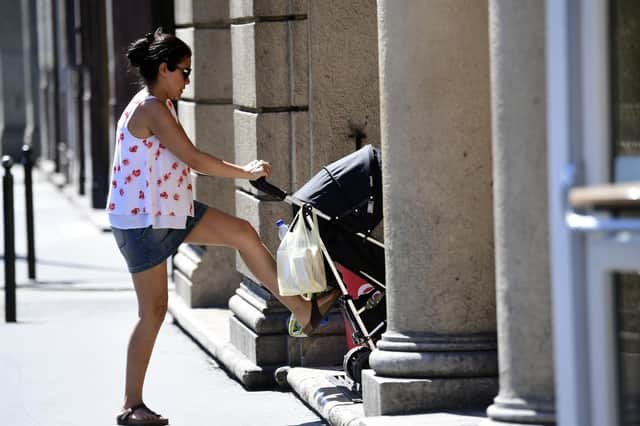SLAVERY: INDENTURED SERVITUDE
Are au pairs to become a thing of the past?Máté Horváth looks back on his time working as an au pair in Edinburgh as a life changing experience.
By Jane Bradley
Published 30th Apr 2023,

Au pair schemes were originally set up to be cultural exchange programmes.
“I really enjoyed the experience, and the different culture,” he says. “It was safe, it gave me another culture and new friends. This experience opened my view, and changed the way I think about the world.”
Mr Horváth, who, ten years later, is now married with three children of his own and settled in his native Hungary, spent a year living with a Scottish family, where he looked after their two children in return for food, board and a small salary.
"At school, I learned English and Latin,” he says. “So I had just one option to travel abroad: Great Britain. I wanted to try to improve my language skills.”
“I really enjoyed the experience, and the different culture,” he says. “It was safe, it gave me another culture and new friends. This experience opened my view, and changed the way I think about the world.”
Mr Horváth, who, ten years later, is now married with three children of his own and settled in his native Hungary, spent a year living with a Scottish family, where he looked after their two children in return for food, board and a small salary.
"At school, I learned English and Latin,” he says. “So I had just one option to travel abroad: Great Britain. I wanted to try to improve my language skills.”

Máté Horváth, from Hungary, was an au pair in Edinburgh ten years ago.
Working as an au pair is often seen as a rite of passage for young people, like Mr Horváth, looking for an opportunity to experience culture abroad – and a useful source of live-in childcare for busy, working families. Around 20 countries in the world from China to France, the US and Canada have an au pair scheme.
From the French “au pair”, meaning “at par”, the term was used to describe the economic parity between the employee and employer – an exchange of work for a cultural experience.
Working as an au pair is often seen as a rite of passage for young people, like Mr Horváth, looking for an opportunity to experience culture abroad – and a useful source of live-in childcare for busy, working families. Around 20 countries in the world from China to France, the US and Canada have an au pair scheme.
From the French “au pair”, meaning “at par”, the term was used to describe the economic parity between the employee and employer – an exchange of work for a cultural experience.
Now, however, the numbers of people living in a foreign country in exchange for childcare and light housework has fallen, amid changes to immigration rules – and politicians’ fears that au pairs, who are often not subject to the same employment rules and rights as regular workers, could be being exploited.
In Norway, the government has this month put forward a proposal to scrap its scheme to permit foreign workers to enter the country as au pairs, amid fears that they are being exploited by the families who employ them.
Meanwhile, in the UK, the number of au pairs has plummeted since Britain left the European Union. Now, only people who already have the right to work in the UK can be taken on as an au pair, removing potential applications from most people from the 27 EU member states, unless they already had leave to remain in Britain. A separate visa pathway for au pairs was scrapped by the Home Office in November 2008 and despite a campaign led by the British Au Pair Agencies Association to re-establish a similar scheme after Brexit, the idea was not taken up by the UK Government.
Even in countries still operating a working au pair scheme, controversy is rife. An Australian study published in 2018 found the majority of foreign au pairs working in Australia, where they can be employed on a working holiday visa, were being asked to do housework on top of their childcare duties by families taking advantage of cheap labour, while au pairs from South America living in the US have complained of being exploited.
Mr Horváth had a good experience, taking the children of his employers to school and to extra curricular activities. He is concerned that fewer young people will be able to have the cultural opportunity he had.
“The family I lived with was very kind, patient, and lovely,” he remembers. “Before I moved, we talked around three or four times and the duties were clear. Sometimes, it was not easy to live in a family, because everything was totally different: the language, the weather, the rules, the people. But this was the reason why I wanted to travel.
"I really loved Edinburgh, it is so different to home. At my time, it was easy to travel, and easy to start working as an au pair. If it is not easy to travel and work now, less young people will be able to have that opportunity.”
In Norway, the decision to scrap the scheme has come following a string of court cases relating to situations where some people employed under the au pair scheme – many of them young women from the Philippines – were exploited by their employer.
In 2017, wealthy Norwegian investor Ragnar Horn and his wife, Joey Shaista Horn, were jailed for five months for fraudulently and illegally using two young women from the Philippines as au pairs at the same time, and putting them to work as their low-paid household help.
This came a year after Norway’s state immigration agency UDI ruled that 45 Norwegian families should be prohibited from having au pairs in their homes, because of the families’ alleged violations of the programme.
Peggy Hessen Følsvik, head of Norway’s largest labour confederation, LO, has branded the practice a form of “slavery”.
"Unfortunately, the scheme has given us many examples of gross exploitation of women. I am simply relieved that this scheme has now been put to an end,” she said.
Norwegian labour minister Marte Mjøs Persen last month submitted a proposal to end the au pair residence permit scheme. The plan is now out for consultation, which will run until the end of June, although it is likely to be approved.
“It is a system that does not work as intended. It is no longer a cultural exchange scheme as it once was. The scheme is used to obtain cheap labour in the home, either for childcare or housework,” she told Norwegian media.
“Even though many au pair live well with their host families, the program has also become a loophole to get cheap workers. The time when the au pair program was seen as a cultural exchange is over.”
One mother, from Edinburgh, says she was careful to do everything “by the book” when she employed an au pair to look after her three children. UK regulations state that au pairs should be given time to study and practise their English with the host family, as well as attending language lessons – and should not be expected to work for more than 30 hours a week.
She has taken in four different au pairs at different times – all from France, where the family has previously lived.
"We always gave the au pairs the opportunity to eat with us, although we were lucky that we have a sort of granny flat, so they had their own space if they wanted it,” she says.
"We did our best to teach them about Scottish culture, and we also paid for them to go to a language school while they were here if they wanted to.
"It gave the children an opportunity to keep up their French, but they’re not here to be nannies, they were more like a big sister and that was really nice for the kids. We’re older parents and the younger au pair can run around in the garden and jump on the trampoline a bit more than we can.
"We have stayed in touch with some of them and they have come to visit us again.”
How can au pairs work in the UK and other countries?
Au pairs wanting to live with a family in the UK need to already have permission to work here, meaning that since Brexit, the number of potential employees has greatly reduced. No specific pathway has been created for au pairs to enter the UK separately, since the Home Office scrapped a previous visa pathway in 2008.
Outside of those who already have a UK working visa, nationals who are eligible to apply under the Youth Mobility Scheme Visa – from Australia, Canada, Monaco, New Zealand, San Marino and Iceland – also have the opportunity to look for work as an au pair.
Au pairs usually live with the family they work for and are unlikely to be classed as workers or employees. They are not entitled to the National Minimum Wage or paid holidays.
Instead, they are treated as a member of the family they live with and get “pocket money” instead - usually at least £90 a week. However, depending on how much pocket money” they earn, they may have to pay Income Tax and National Insurance. They are also expected to be given time to study and practise their English with the host family, as well as attending language lessons.
Some countries have a separate route for those wanting to work as an au pair – while others require applicants to hold a working holiday visa, or be paid full salaries in accordance with minimum wage requirements.
In Spain, for example, applicants have to fulfil certain criteria, such as not being married, not having children of their own and having experience in childcare. They also need the right to live and work in the country – such as EU citizenship or an existing working visa.


















